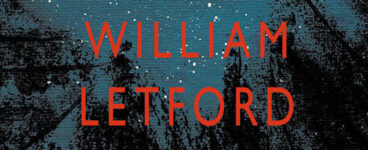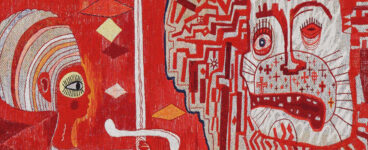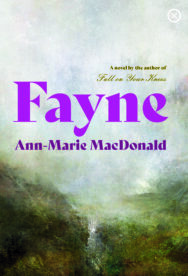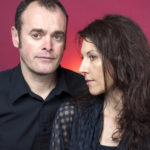‘My tutor opened for me daily the Book of Life and bid me peruse where I would in pursuit, not so much of answers – for answers are abundant as drones in a hive – but Questions. A good Question is the queen bee.’
The stunning work of historical fiction by Ann-Marie MacDonald soon to be available in the UK via Tramp Press, Fayne presents a feminist twist on the genre, detailing the struggle of the gifted Charlotte to escape the strict boundaries of her life as a young woman in the gloomy 19th century Scottish Borders. Whet your appetite with this extract in which the budding gifts of Charlotte reveal themselves through a developing bond with her chemistry tutor.
Fayne
By Ann-Marie MacDonald
Published by Tramp Press
I had expected that a tutor was a sort of vessel which would tip and empty its contents into my brain and I would be full of education. Instead, my tutor opened for me daily the Book of Life and bid me peruse where I would in pursuit, not so much of answers – for answers are abundant as drones in a hive – but Questions. A good Question is the queen bee.
Each day was packed as full with wonders as Mr Margalo’s trunk. The first day was characterised by, ‘A general introduction to chemistry. Let us begin with the known elements.’
‘That’s easy: earth, air, fire and water.’
By way of answer, he laid before me a sheet of vellum whereon was depicted an asymmetrical chart divided into squares, in each of which appeared words – many unfamiliar – accompanied by initials and numbers. The whole effect was nothing if not runic and for a mad moment I wondered whether my tutor had transcribed Byrn’s dialect. ‘This, Miss Bell, is the Periodic Table. Your first task shall be to commit it to memory, one line per day, such that in due course—’
‘I have it, Mr Margalo.’
‘You have …?’
Taking up a pencil, I turned the sheet of paper over and rendered a reproduction of the “table”. He looked perturbed. ‘Have I left something out?’ I asked.
‘No …’
‘What do these letters and numbers mean?’
‘They are abbreviations denoting the known elements.’
‘Do you mean to say there are in excess of four elements?’
‘There are sixty-three. And counting.’
‘Huzzah!’
On the second day, the library table became a laboratory bench. I began by combining several drops of a pale-blue liquid known as hydrogen peroxide with a measure of pig’s blood (not Maisie’s) to produce a foaming pink mixture which overflowed its “test tube”! This I followed with a chemical sleight of hand involving a granular purplish substance called potassium permanganate (KMnO4 to the initiated), ordinary H2O (water, to the layman), sugar and sodium hydroxide (lye), the which I stirred together in a “beaker” whereupon the clear liquid turned violet, then green, then yellow, then red!! After luncheon – I scarcely noticed what I ate (stovies) – the sorcery of combining crystals of iodine with dust of zinc and a drop of water produced an audible “poof” simultaneous with a puff of bright purple smoke, such that I fancied myself a budding Merlin!!!
On the third day, Mr Margalo introduced ‘some principles of mechanical engineering’. Reader, I built a steam engine; diminutive, to be sure, nonetheless capable of setting a cork disk to spinning in a basin of water by means of a loop of copper tubing and a candle. Thus did I wield with my own hands the power that had ignited the Industrial Revolution and drove it still, for what was my spinning cork but a flywheel writ small? A thundering locomotive, a chugging ocean liner, a piston pump in a mine where coal was dug to make the heat to turn the water into steam to drive the pump to keep the mine from flooding?!!!!
As Mr Margalo observed, ‘Some of the simplest feats of applied physics are among the most profound. Archimedes said—’
“‘Give me a long enough lever and a fulcrum and I shall move the Earth.’”
‘Quite right.’
‘I say, Mr Margalo, how long a lever might be required to lift Mrs Knox and Cruikshank with the touch of a finger?’
‘We merely must calculate their combined weight in relation to the amount of force exerted by your finger …’ I applied the formula and found said lever would need to be impracticably long in relation to a fulcrum impracticably high in order to send the two of them sailing, at the touch of my finger, over the house. (Safely into a bed of hay.) But it was possible. ‘Theoretically.’
Following luncheon – it signifies not what we ate, but that we ate together (sausage and mash) – my tutor sketched a diagram with mathematical notations, of a magnificent structure even then under construction in Edinburgh: a cantilever railway bridge!!!!! It was dizzying to envision arm after steel arm thrown out over the void whilst the whole remained stable and sound. “Unlike the Tay Bridge.” Whereupon he told me a tale of manmade disaster that haunts me still – the darkness, the freezing water, the plunge of a passenger locomotive … the drowned hopes of Yuletide. And yet, the ponderous grid of the Tay Bridge had appeared sounder to the untrained eye than the elegant geometry of the Forth Bridge. So much for appearances.
We spent the remainder of the afternoon in fashioning a suspension bridge out of matchsticks with needle and thread –
‘And here’s me thinking pixies had took it, what’re you after with me sewing basket?!’
‘Science, Knoxy.’
On the fourth day, Mr Margalo schooled me in the law of gravity.
‘Mr Margalo, I have seen the drawing of Leonardo’s flying machine, and Father says we shall, within my lifetime perhaps, take to the skies on manmade wings. Do you believe we shall defy gravity?’
‘That which we do every day would have been counted magic less than a century ago – capturing lightning in a bottle, taming it to run along copper wire, sending messages through cables that span the ocean floor.’
He illustrated the physics of bodies in motion by way of an experiment: we ascended to the upper gallery of the schoolroom (as I now called the library) whence he dropped a piece of chalk.
‘Why does the chalk not fall upward, Miss Bell?’
‘Silly question.’
‘Is it?’
‘Because that would be … impossible.’
‘Why?’
‘Um.’
‘We take it for granted. And yet it is the force of gravity. Newton showed that every object attracts every other object, which is why all things – including these books, this house, ourselves – do not simply fly asunder. And float away.’
He paused. I gaped. He continued. ‘When I dropped the chalk, Earth exerted a force upon it, drawing it to Herself. But the chalk, likewise, exerted a force on Earth. These forces, we can measure.’ His brown eyes were gleaming now and I was rapt. ‘Which of these two objects, if we drop them simultaneously, do you predict will land first, Miss Bell?’
‘Why the heavier, of course. Aristotle is clear on that point and common sense bears him out.’
We extended each an arm over the railing; he dropped an egg (boiled) and I, simultaneously, a cabbage. They landed at the same time. I could hardly credit it. We reproduced the results with a turnip. A yelp from below alerted us to Cruikshank and thus us to luncheon.
Fayne by Ann-Marie MacDonald is published by Tramp Press, priced £15.99.
ALSO IN THIS ISSUE

 From Our Own Fire
From Our Own Fire
‘Friend, you have begun your journey into a vast and lonely space. Life is abundant. But intelligent …

 Grayson Perry: Smash Hits
Grayson Perry: Smash Hits
‘His trademark interests – masculinity, sex, taste, class, religion and the art world – are ever-pre …













